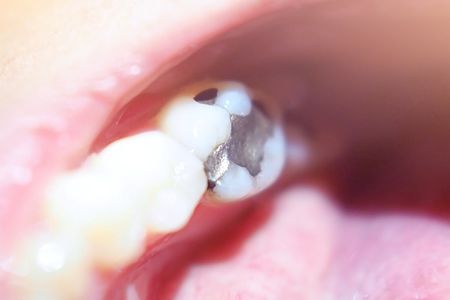The Shift Toward Mercury-Free Dentistry
 Royal Dubai
31 Jul, 2025
7 mins read
4
Royal Dubai
31 Jul, 2025
7 mins read
4

The dental industry is undergoing a significant transformation with a clear shift toward mercury-free dentistry. As awareness grows around the potential health and environmental concerns related to traditional amalgam fillings, more patients are exploring options for filling removal and replacement with safer, mercury-free materials. This movement is reshaping dental care practices worldwide, promoting safer alternatives and improved patient outcomes.
Understanding Mercury in Dental Fillings:
Mercury has been a key component in dental amalgam for over a century due to its durability and affordability. However, the presence of mercury—a heavy metal known for its toxicity—has raised questions about the long-term safety of these fillings.
Why Mercury Was Used:
- Provides strong, durable restorations
- Cost-effective compared to other materials
- Easy to manipulate and place in cavities
Concerns Leading to Change:
- Mercury vapor release during chewing or grinding
- Potential environmental pollution during disposal
- Growing preference for biocompatible materials
Advantages of Mercury-Free Alternatives:
Dentistry now offers several mercury-free filling materials that cater to both cosmetic and health-conscious patients.
Common Mercury-Free Options:
- Composite Resins: Tooth-colored, aesthetic, and bond well to enamel
- Glass Ionomer Cements: Release fluoride, beneficial for certain patients
- Ceramic Fillings: Highly durable and natural-looking
- Gold Fillings: Long-lasting though more costly
Benefits of Choosing Mercury-Free Fillings:
- Improved appearance blending with natural teeth
- Reduced concerns about mercury exposure
- Potentially less invasive preparation of tooth structure
- Environmentally safer disposal processes
The Role of Filling Removal in Mercury-Free Dentistry:
For individuals with existing amalgam restorations, filling removal plays a crucial role in transitioning to mercury-free dentistry.
Considerations for Safe Removal:
- Removal should be done by trained professionals using protective measures
- Use of rubber dams and high-volume suction to minimize mercury vapor exposure
- Proper disposal of amalgam waste in compliance with environmental regulations
When to Consider Removal:
- Presence of cracks or deterioration in existing fillings
- Allergic reactions or sensitivity to amalgam components
- Personal preference for mercury-free dental care
- Cosmetic reasons seeking a natural tooth appearance
Environmental Impact Driving the Shift:
One of the most powerful motivators behind mercury-free dentistry is the environmental concern regarding mercury pollution.
How Amalgam Affects the Environment:
- Mercury can contaminate water systems if not disposed of correctly
- Dental offices historically contributed to mercury emissions in wastewater
- Mercury accumulates in ecosystems, affecting wildlife and human health
Mercury-Free Dentistry Promotes:
- Reduced mercury usage and safer waste management
- Adoption of technologies such as amalgam separators in clinics
- Increased public awareness and regulatory support
Challenges in the Transition to Mercury-Free Dentistry:
While the benefits are clear, some challenges remain in fully adopting mercury-free practices.
Common Barriers:
- Higher cost of alternative materials for some patients
- Limited availability of skilled practitioners in certain regions
- Resistance due to the long-standing use and trust in amalgam fillings
- Need for ongoing education and policy support
How Technology Supports Mercury-Free Dentistry:
Innovations in dental technology are critical in making mercury-free options more accessible and effective.
Technological Advances Include:
- Enhanced composite materials with better durability and aesthetics
- Digital scanning and CAD/CAM systems for precise ceramic restorations
- Improved techniques for safe filling removal and replacement
- Amalgam separators and filtration systems reducing environmental impact
What Patients Should Know About Mercury-Free Dentistry:
Patients considering the transition to mercury-free dental care should be well-informed about the process and benefits.
Key Points for Patients:
- Discuss with your dentist about the best mercury-free options for your dental health
- Ensure your dentist follows strict safety protocols during any filling removal
- Understand the costs and benefits of alternative materials
- Consider your personal health concerns and cosmetic preferences
The Future Outlook of Mercury-Free Dentistry:
The dental field is moving steadily towards safer, more environmentally friendly practices that minimize or eliminate mercury use.
Predicted Trends:
- Further regulatory restrictions on amalgam usage globally
- Wider adoption of mercury-free materials in general practice
- Enhanced patient demand for biocompatible and aesthetic restorations
- Continued research into new materials and techniques improving durability and safety
Conclusion:
The shift toward mercury-free dentistry represents a positive step for both patient health and environmental protection. As more individuals opt for filling removal and mercury-free alternatives, dental care continues to evolve into a safer, more sustainable practice. Patients and professionals alike are benefiting from innovations that prioritize well-being without compromising on quality or durability.
Written By:
Royal Dubai



Hotels at your convenience
Now choose your stay according to your preference. From finding a place for your dream destination or a mere weekend getaway to business accommodations or brief stay, we have got you covered. Explore hotels as per your mood.


